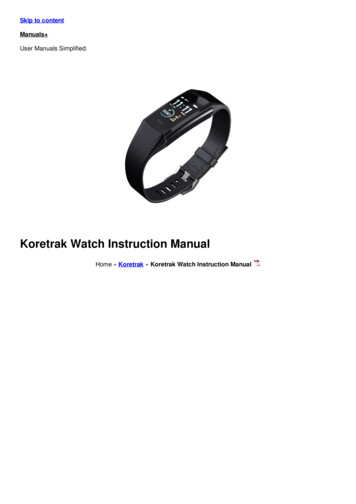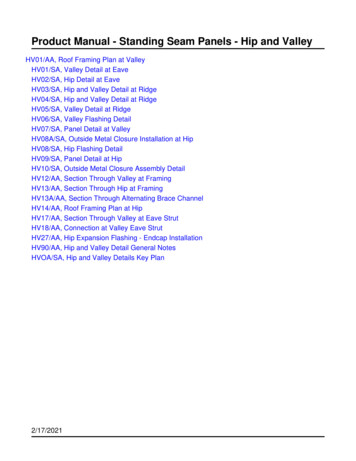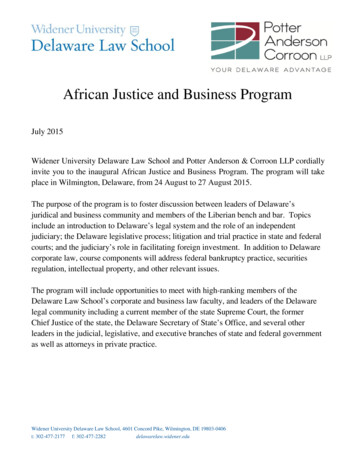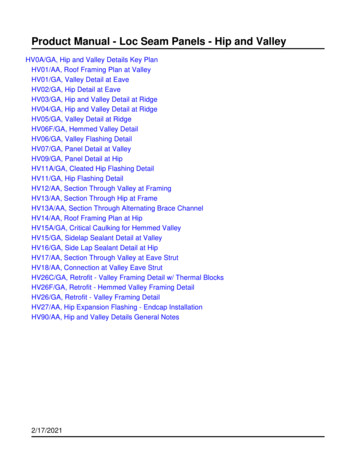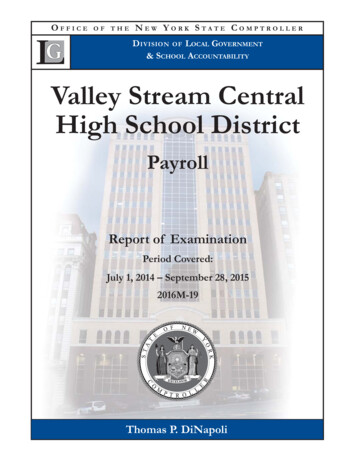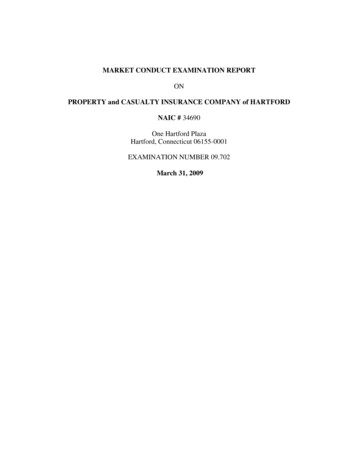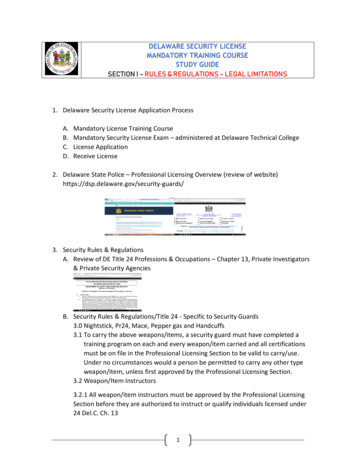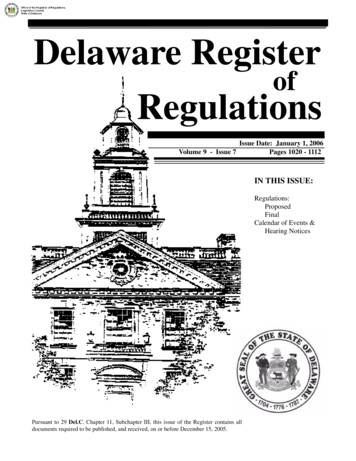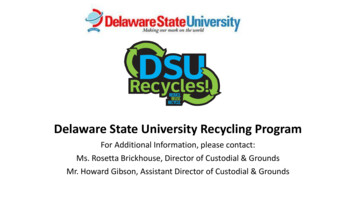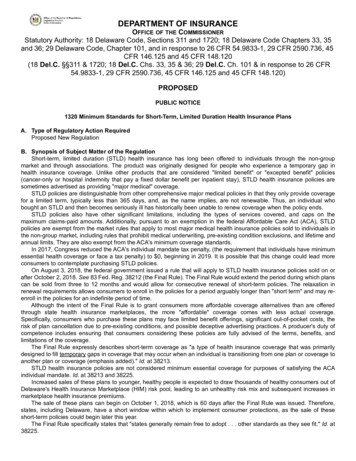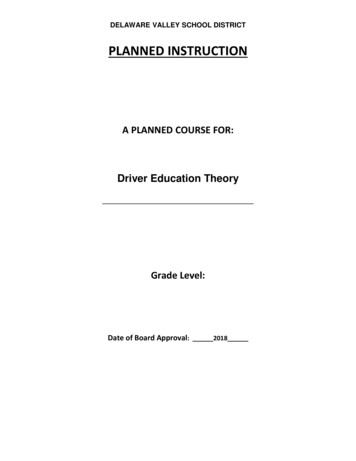
Transcription
DELAWARE VALLEY SCHOOL DISTRICTPLANNED INSTRUCTIONA PLANNED COURSE FOR:Driver Education TheoryGrade Level:Date of Board Approval: 2018
DELAWARE VALLEY SCHOOL DISTRICTPlanned InstructionTitle of Planned Instruction: Driver EducationSubject Area:Driver Education TheoryGrade(s): 10Course Description:This course will help prepare the student for the legal aspects and responsibilities for drivingin Pennsylvania. The class will cover obtaining of a license and the legal and financialaccountability associated with driving privileges. The student will have knowledge of thevehicle for basic operation and understand the concepts necessary to safely maneuver thevehicle forwards and backwards. The student will have the information necessary to respondproperly to emergency situations. The student will learn about the Pennsylvania VehicleCode and understand the consequences associated with Vehicle Code violations. The studentwill learn to visually analyze driving scenes and use defensive driving principles to constructtheoretical responses to traffic situations. Upon completion of this course students will beable to thoroughly assess the Highway Transportation System in our area. The students willalso discuss drinking, driving, and drugs and the consequences and impact of mixing thesechoices in the future.Time/Credit for the Course: 45 daysCurriculum Writing Committee:Sean Giblin
DELAWARE VALLEY SCHOOL DISTRICTCurriculum Map1. Marking Period One -Overview with time range in days:Unit 1: Introduction to Novice Driver Responsibilities and the Licensing System (3Days)Unit 2: Getting Acquainted with the Vehicle (3 Days)Unit 3: Understanding Vehicle Control: Starting, Steering, and Stopping (3 Days)Unit 4: Traffic Control Devices and Laws (3 Days)Unit 5: Vision and Space Management (4 Days)Unit 6: Basic Maneuvers in a Low-Risk (4 Days)Unit 7: Risk Reducing Strategies for Different Driving Environments (5 Days)Unit 8: Sharing the Road with Other Users (3 Days)Unit 9: The Effects of Distractions on Driving (3 Days)Unit 10: Adverse Driving Conditions and Emergencies (4 Days)Unit 11: Impaired Driving (3 Days)Unit 12: The Effects of Fatigue and Emotions on Driving (3 Days)Unit 13: Travel Planning, Loading, Towing and Driving Special Vehicles (2 Days)Unit 14: Tire Safety (2 Days)
DELAWARE VALLEY SCHOOL DISTRICTUNIT: Introduction to Novice Driver Responsibilities and the Licensing SystemBig Idea # 1: Physical, mental, and social skills are needed for basic car control, overallawareness and the ability to effectively communicate with other drivers.Essential Questions: What are the Pennsylvania Department of Transportation licensing procedures? How are risk management strategies related to successful driving behaviors?Concepts: Knowledge of the licensing process is essential for acquiring driving privileges inPennsylvania. Knowledge of the appropriate application of risk prevention, acceptance, avoidance,reduction, and protection strategies.Competencies: Students will explain the licensing process. Students will identify risk factors in various driving situations. Students will apply risk management strategies in theoretical driving situations.
DELAWARE VALLEY SCHOOL DISTRICTCurriculum PlanUnit: Introduction to Novice Driver Responsibilities and the Licensing SystemTime Range in Days: 3 DaysStandard(s):PA Academic StandardsStandards Addressed:14.1.CE.B, 14.1.CE.C, 14.4.CE.A, 14.4.CE.G, 16.3.12.AAnchor(s):R11.A.2.1 Identify and apply the meaning of vocabulary in nonfiction.Overview:Unit 1 is designed to introduce the student to the structure, goals, policies and procedures ofDelaware Valley’s driver education program. The students and will also learn about theirstate’s licensing system requirements. The responsibilities of collision-free and violation-freedriving will also be introduced.Focus Question(s): What are the Pennsylvania traffic laws and licensing procedures?Goals: Students will secure a PA Junior Learner’s PermitObjectives: Students will understand the process for obtaining a PA Junior Learner’s Permit.Students will list the steps for securing a PA Driver’s License.Students will understand that driving is a complex task that involves risk and decisions aboutrisk-taking.Students will utilize risk management methods to solve problem driving situations.Core Activities and Corresponding Instructional Methods: Introduce students to the Delaware Valley Driver Education DepartmentIntroduce Word Wall wordsOverview of GDLOverview of Pennsylvania Licensing SystemState Licensing Learning ActivityRisk and Risk-taking discussion
DELAWARE VALLEY SCHOOL DISTRICTAssessments:Diagnostic: Pretest: Licensing and Risk Assessment Formative:State Licensing ActivityUnit 1 Review QuestionsWord WallSummative:Unit 1 TestExtensions: Complete the process for obtaining a PA Junior Learner’s permit.Correctives: Construct a timeline on the application process for obtaining a permit and a license inPA Student-led discussion by those who have gone through the process of obtaining alicense and a permit to better understand the procedure. Students will be directed to the relevant chapter in Responsible Driving for furtherexplanation.Materials and Resources: PA Driver’s Manual, Chapter 1ADTSEA Driver Education Curriculum 3.0, Unit 1Responsible Driving, Ch 1Video: ADTSEA 3.0, 1.5 – Driver EducationFact Sheet: ADTSEA 3.0, 1.6 – Unit 1 Words to Know MatchupVideo Review: ADTSEA 3.0, 1.5 – Driver EducationUnit 1 Test
DELAWARE VALLEY SCHOOL DISTRICTUNIT: Getting Acquainted with the VehicleBig Idea # 1: Physical, mental, and social skills are needed for basic car control, overallawareness and the ability to effectively communicate with other drivers.Essential Questions: How does a driver apply risk management to their everyday driving behaviors? When analyzing the instrument panel, how can we assess if there is an issue with ourvehicle?Concepts: Knowledge of the devices inside the vehicle designed to protect, communicate, and control. Knowledge of the appropriate procedures for entering and preparing to start the vehicle.Competencies: Students will describe and identify gauges, lights, instruments found on the dashboard andinside the vehicle. Students will identify the types of occupant protection and explain how they work.
DELAWARE VALLEY SCHOOL DISTRICTCurriculum PlanUnit: Getting Acquainted with the VehicleTime Range in Days: 3 DaysStandard(s):PA Academic StandardsStandards Addressed:14.1.CE.B, 14.2.CE.A, 14.2.CE.B, 14.2.CE.C, 14.2.CE.EAnchor(s):R11.A.2.1 Identify and apply the meaning of vocabulary in nonfiction.Overview:Unit 2 will help the student become acquainted with his/her vehicle by introducing thefollowing concepts: how to make routine checks prior to entering the vehicle, how tocompensate for the area around the vehicle that cannot be seen, how to perform pre-driveprocedures, why safety restraints are important, how to locate and operate the vehicleinformation and control devices, how to interpret the control and information devicesymbols, how to set and use mirrors, how to use reference points, and how to use the vehicleowner’s manual.Focus Question(s): What pre-entry checks should be made around the vehicle? What protective devices are available for occupants of motor vehicles? What are the functions of safety, communication, comfort, convenience, and controldevices? What pre-drive procedures are followed before starting the vehicle? How are reference points used to position the vehicle in the roadway? What are enhanced mirror settings?Goals: Students will be able to perform pre- and post-trip inspections and adjustments. Students will be able to locate and use informational and control devices in theirpersonal vehicle.Objectives: Students will describe pre-entry checks to be made around the vehicle. Students will identify the obscured areas around the vehicle.
DELAWARE VALLEY SCHOOL DISTRICT Students will demonstrate knowledge of and proper usage of protective devicesavailable to occupants of motor vehicles. Students will identify and describe the location, function and operation of safety,communication, comfort, convenience, and control devices, as well as control andinformation device symbols found in a passenger vehicle in preparation for starting thevehicle. Students will describe the pre-drive procedures used after entering the vehicle anddemonstrate knowledge of enhanced mirror settings and mirror usage. Students will demonstrate knowledge of standard and personal vehicle reference pointsto know where the vehicle is positioned in relation to the roadway. Students will describe the purpose and use of the vehicle owner’s manual.Core Activities and Corresponding Instructional Methods: Introduce Word Wall wordsDiscuss pre-entry checks.Discuss sight-line limitations.Discuss proper usage of protection devices in a motor vehicle.“Survival 101” – Officer Moglia presentation.Discuss new advances in vehicle safety.Discuss the location, function and operation of safety, communication, comfort,convenience, and control devices.“Dashboard BINGO”.“What am I?” device identification activity.Discuss pre-drive procedures used after entering the vehicle.Demonstrate enhanced mirror settings vs. traditional mirror settings.Discuss vehicle reference points.Assessments:Diagnostic: Pre-test Getting Acquainted with the VehicleFormative: “Dashboard BINGO” activity “What am I?” identification activitySummative: Unit 2 Test
DELAWARE VALLEY SCHOOL DISTRICTExtensions: Students will create an informational video on how to perform procedures covered inUnit 2. Students will create an informational video on seat belt safety.Correctives: Words to Know Matchup. Students will look in a vehicle manual to help locate device symbols. Students will be directed to the appropriate chapters of Responsible Driving for furtherreview.Materials and Resources: PA Driver’s Manual, Chapter 3ADTSEA Driver Education Curriculum 3.0, Unit 2Responsible Driving, Chapter 1Video: ADTSEA 3.0, 2.1 Pre-Entry ChecksVideo: ADTSEA 3.0, 2.2 The Area Around the VehicleVideo: ADTSEA 3.0, 2.3 Reducing Your Risks in the CrashVideo: ADTSEA 3.0, 2.4 Getting to Know the VehicleVideo: ADTSEA 3.0, 2.5 Pre-Drive Procedures, Mirrors and Blind SpotsFact Sheet: ADTSEA 3.0, 2.8 Words to Know Definitions PageWorksheet: ADTSEA 3.0, 2.4.1 Safety, Communication, Control and Convenience DevicesWorksheet: ADTSEA 3.0, 2.4.2 Control and Information Device SymbolsWorksheet: ADTSEA 3.0, 2.4.3 Instrument PanelWorksheet: ADTSEA 3.0, 2.6 Identifying Reference PointsWorksheet: ADTSEA 3.0, 2.8 Words to Know MatchupUnit 2 Test
DELAWARE VALLEY SCHOOL DISTRICTUNIT: Understanding Vehicle Control: Starting, Steering, and StoppingBig Idea # 1: Physical, mental, and social skills are needed for basic car control, overallawareness and the ability to effectively communicate with other drivers.Essential Questions: How does a driver apply risk management to their everyday driving behaviors? What are the procedural steps for starting, backing, stopping and securing the vehicle?Concepts: Knowledge of the appropriate procedures for starting, backing, stopping and securing thevehicle.Competencies: Students will explain starting, backing, stopping and securing procedures. Students will demonstrate correct hand position and steering techniques. Students will identify risk factors in various driving situations. Students will apply risk management strategies in theoretical driving situations.
DELAWARE VALLEY SCHOOL DISTRICTCurriculum PlanUnit: Understanding Vehicle Control: Starting, Steering, and StoppingTime Range in Days: 3 DaysStandard(s):PA Academic StandardsStandards .CE.CAnchor(s):M11.D.3.1.2 Determine how a change in one variable relates to a change in a second variableR11.A.2.5.1 Summarize the major points, processes, and/or events of a nonfiction text as awhole.Overview:Unit 3 will help the student understand vehicle control. Starting the engine, moving thevehicle forward, steering the vehicle, moving to curb/side of road, entering a roadway from acurb, stopping the vehicle, backing the vehicle and securing the vehicle for parking will becovered.Focus Question(s): What are the procedural steps for starting the engine and moving the vehicle forward? What is the proper hand position on the steering wheel? What are the procedural steps for entering and exiting a curb? What are the procedural steps for stopping and securing the vehicle? What are the procedural steps for backing the vehicle?Goals: Students will demonstrate basic operating procedures.Objectives: Student will demonstrate knowledge of procedural steps for starting the engine andmoving the vehicle forward.
DELAWARE VALLEY SCHOOL DISTRICT Student will demonstrate proper hand position on the steering wheel and identify thedifferent techniques of steering a vehicle. Student will demonstrate knowledge of procedural steps for moving to curb/side ofroad and entering the roadway from a curb. Student will demonstrate knowledge of procedural steps for stopping and securing thevehicle. Student will demonstrate knowledge of procedural steps for backing the vehicle. Student will define key words associated with the unit objectives.Core Activities and Corresponding Instructional Methods: Introduce Word Wall words.Discuss starting the engine and moving the vehicle forward.“Starting the Engine and Moving the vehicle forward” activity.“Vehicle footprint” activity.Discuss hand placement and steering techniques.“Steering wheel” activity.Discuss entering and leaving the curb.Discuss stopping and securing the vehicle.“The ‘Feel’ of braking.”Discuss backing the vehicle.Assessments:Diagnostic: Pre-Test: Understanding Vehicle Control: Starting, Steering and StoppingFormative: Vehicle Footprint Activity Steering Wheel Activity “Feel” of Braking ActivitySummative: Unit 3 TestExtensions: Students with driving privileges will apply concepts of vehicle control to their drivingbehavior.
DELAWARE VALLEY SCHOOL DISTRICTCorrectives: Unit 3 Fact sheets Worksheet 3.6: Words to Know MatchupMaterials and Resources: Responsible Driving: Chapters 4, 5, 6ADTSEA Driver Education Curriculum 3.0, Unit 3PA Driver’s Manual, Chapter 3Video: ADTSEA 3.0, 3.1 Starting the Engine and Moving the Vehicle ForwardVideo: ADTSEA 3.0, 3.2 SteeringVideo: ADTSEA 3.0, 3.3 Entering a Roadway from the CurbVideo: ADTSEA 3.0, 3.4 Stopping and Securing the VehicleVideo: ADTSEA 3.0, 3.5 BackingFact Sheet: ADTSEA 3.0, 3.6 Words to Know Definitions PageWorksheet: ADTSEA 3.0, 3.1 Starting the Engine and Moving the Vehicle ForwardWorksheet: ADTSEA 3.0, 3.3 Entering a Roadway from the CurbWorksheet: ADTSEA 3.0, 3.4 Stopping and Securing the VehicleWorksheet: ADTSEA 3.0, 3.5 BackingWorksheet: ADTSEA 3.0, 3.6 Words to Know Definitions PageUnit 3 Test
DELAWARE VALLEY SCHOOL DISTRICTUNIT: Traffic Control Devices and LawsBig Idea # 1: Traffic signs, signals, rules of the road and roadway markings tell drivers how todrive safely and cooperate with other roadway users.Essential Questions: How do traffic signs, roadway markings, and right of way rules contribute to a safe drivingenvironment?Concepts: Knowledge of the classification of signs, signals and roadway markings to control andregulate traffic.Competencies: Students will explain the significance of the use of signs, symbols, and pavement markingsthrough classification.
DELAWARE VALLEY SCHOOL DISTRICTCurriculum PlanUnit: Traffic Control Devices and LawsTime Range in Days: 4 DaysStandard(s):PA Academic StandardsStandards Addressed:14.1.CE.A14.2.CE.DAnchor(s):R11.A.2.5.1 Summarize the major points, processes, and/or events of a nonfiction text as awhole.Overview:Unit 4 will introduce the student to traffic control devices, including signs, signals andpavement markings, as well as traffic laws specific to Pennsylvania, including right-of-waylaws, obeying a police officer and speed restrictions.Focus Question(s): What is the purpose of traffic control devices? How do colors and shapes help interpret signs, signals and roadway markings? What Pennsylvania specific laws pertain to the response by drivers to traffic controls?Goals: Students will identify and interpret signs, signals and roadway markings throughclassification.Objectives: Student will define and identify the purpose of traffic control devices. Student will recognize and identify the color, shape and meaning of traffic signs. Student will recognize and identify the meaning of traffic control signal lights. Student will recognize and identify the meaning of pavement markings. Student will describe state specific laws pertaining to the required response by thedriver to traffic signs, signals and pavements markings, and the directions of a policeofficer. Student will define key words associated with the unit objectives.
DELAWARE VALLEY SCHOOL DISTRICTCore Activities and Corresponding Instructional Methods: Pennsylvania Sign Quiz – Pretest.Introduce Word Wall words.Discuss definition and purpose of traffic control devices (Worksheet 4.1).Discuss color and shape of traffic signs.Discuss types of traffic signs.“Whiteboard Sign” activity.“Signs and Signals Ball” activity.Discuss traffic and pedestrian signals.“Traffic Lights” activity.Discuss pavement markings.“Pavement Markings” activity.Discuss Pennsylvania traffic and vehicle laws.“DRIVO”Pennsylvania Sign Quiz – Posttest.Unit 4 Test.Assessments:Diagnostic: Pennsylvania Sign QuizFormative: Activity 4.2.1 – Whiteboard Sign activity.Activity 4.2.2 – Signs and Signals Ball activity.Activity 4.3 – Traffic Lights activity.Activity 4.4 – Pavement Markings activity.DRIVOSummative: Pennsylvania Sign Quiz Unit 4 TestExtensions: Students will locate a hazardous intersection in the local area and write a summary ofthe characteristics of the intersection that make it hazardous.
DELAWARE VALLEY SCHOOL DISTRICTCorrectives: Students will make a list of all the traffic signs along a one-mile stretch of road andclassify them. Students will be directed to the appropriate chapters of Responsible Driving for furtherreview.Materials and Resources: Pennsylvania Driver’s Manual: Chapter 2Responsible Driving: Chapters 2 and 3ADTSEA Driver Education Curriculum 3.0, Unit 4Video: ADTSEA 3.0, 4.1 Signs, Signals, and Pavement MarkingsVideo Review: ADTSEA 3.0, 4.1 Signs, Signals, and Pavement MarkingsFact Sheet: ADTSEA 3.0, 4.6 Words to Know Definitions PageWorksheet: ADTSEA 3.0, 4.1 Signs, Signals, and Pavement MarkingsWorksheet: ADTSEA 3.0, 4.2 Words to Know MatchupDRIVO game cards (1 per student)DRIVO sign cardsDRIVO markersPennsylvania Sign Quiz PowerPointUnit 4 Test
DELAWARE VALLEY SCHOOL DISTRICTUNIT: Vision and Space ManagementBig Idea # 1: The SEE space management system is a major aspect of driving and is an ongoingskill that needs to develop.Essential Questions: How does a driver apply the SEE space management system to the everyday driving task? How does the use of the SEE system help drivers break down the environment?Concepts: Understanding the safe driving involves having a visual plan of action.Competencies: Students will describe the three components of the HTS. Students will identify risk factors in various driving situations. Students will apply risk management strategies in theoretical driving situations.Big Idea # 2: Physical, mental, and social skills are needed for basic car control, overallawareness and the ability to effectively communicate with other drivers.Essential Questions: How are risk management strategies related to successful driving behaviors? How do visual skills help manage risk when operating a motor vehicle?Concepts: Knowledge that the driving task involves social, physical, and decision making skills.Competencies: Students will identify reference points necessary for optimal lane placement. Students will identify risk factors in various driving situations. Students will apply risk management strategies in theoretical driving situations.
DELAWARE VALLEY SCHOOL DISTRICTCurriculum PlanUnit: Vision and Space ManagementTime Range in Days: 5 DaysStandard(s):PA Academic StandardsStandards Addressed:14.3.CE.A, 14.3.CE.B, 14.3.CE.C, 14.4.CE.A, 14.5.CE.AAnchor(s):M11.D.3.1.2 Determine how a change in one variable relates to a change in a second variableR11.A.2.5.1 Summarize the major points, processes, and/or events of a nonfiction text as awhole.Overview:Unit 5 will introduce operator procedural and information processing tasks in a low riskdriving environment. Basic vehicle maneuvering tasks will include vehicle operating spaceand an introduction to the space management system. The SEE space management system willbe used to determine appropriate roadway position, appropriate vehicle speed, andappropriate communication with other users. Roadway characteristics discussed will beinteraction with intersections, surface conditions, and traffic controls. Looking for open, closed,and changing areas of space and divided attention/multitasking will also be discussed.Focus Question(s): How do visual skills help manage risk when operating a motor vehicle? What is the vehicle operating space? What is stopping distance? What are the processes of the SEE space management system? What are the procedures for selecting and position the vehicle in the proper laneposition? How does a driver divide attention between path of travel and demands inside thevehicle?Goals: Students will connect the processes of the SEE space management system to makeprocedural and information processing decisions.
DELAWARE VALLEY SCHOOL DISTRICTObjectives: Students will identify and describe how effective visual skills help to manage risk whenoperating a motor vehicle. Students will identify the vehicle operating space and maintain an adequate spacecushion. Students will define stopping distance and how it applies to the space around thevehicle. Students will demonstrate knowledge of the space management system SEE. Students will demonstrate knowledge of the search process and describe where, when,how and what a driver needs as part of the search process. Students will demonstrate knowledge of the evaluating risk process. Students will demonstrate knowledge of the executing process for making anappropriate response. Students will demonstrate knowledge of procedures for selecting and positioning amotor vehicle in the proper lane for safe, smooth driving. Students will identify how to divide attention between path of travel and demandsinside the vehicle. Students will define key words associated with the unit objectives.Core Activities and Corresponding Instructional Methods: Introduce Word Wall words.Discuss Vision and Perception Requirements.Discuss Vehicle operating space.Discuss Stopping distance.Discuss SEE Space Management System.“Flash Slide” Activity.“Juggling Multiple Hazards” Activity.“SEE Steps” Activity.Discuss lane positions and making safe lane position adjustments.Discuss divided attention and multitasking.Unit 5 Test.Assessments:Diagnostic: Words to Know MatchupFormative: Flash slide activity
DELAWARE VALLEY SCHOOL DISTRICT SEE steps activitySummative: Unit 5 TestExtensions: Students will use a computer to complete the driverZed 3.0 student program. Students will use a video camera from the passenger seat to record an adverseweather condition and write a summary of the HTS factors that were witnessed.Correctives: Words to Know Matchup. Students will be directed to the appropriate chapters of Responsible Driving for furtherreview.Materials and Resources: Pennsylvania Driver’s Manual: Chapter 3ADTSEA Driver Education Curriculum 3.0, Unit 5Responsible Driving: Chapters 4, 5, 7, 8, and 12Video: ADTSEA 3.0, 5.2 Managing SpaceVideo: ADTSEA 3.0, 5.3 Stopping DistanceVideo: ADTSEA 3.0, 5.4.1 Searching AheadVideo: ADTSEA 3.0, 5.4.2 Searching to the Sides and Looking BehindVideo: ADTSEA 3.0, 5.4.4 Hazard RecognitionVideo: ADTSEA 3.0, 5.4.5 CommunicationFact Sheet: ADTSEA 3.0, 5.7 Words to Know Definition PageWorksheet: ADTSEA 3.0, 5.7 Words to Know MatchupUnit 5 Testdriver-Zed 3.0
DELAWARE VALLEY SCHOOL DISTRICTUNIT: Basic Maneuvers in a Low-Risk EnvironmentBig Idea # 1: Physical, mental, and social skills are needed for basic car control, overallawareness and the ability to effectively communicate with other drivers.Essential Questions: How does the development of physical, mental, and social skills improve a roadway user’soverall safety on the road? Why is there a higher collision and fatality rate at intersections?Concepts: Understanding that the driving task involves social, physical and decision making skills. Knowledge of basic car maneuvers that are essential for safe and efficient driving. Knowledge that parking the vehicle will be based on terrain and the design of the parkinglot. Understanding that intersections are the most dangerous places to drive and have thehighest crash rates.Competencies: Students will explain the process for performing a proper turn. Students will explain the key steps in angle, parallel, perpendicular and hill parking. Students will explain the procedures to be followed at controlled and uncontrolledintersections. Students will understand the right of way rules for proceeding through intersections. Students will identify risk factors in various driving situations. Students will apply risk management strategies in theoretical driving situations.
DELAWARE VALLEY SCHOOL DISTRICTCurriculum PlanUnit: Basic Maneuvers in a Low-Risk EnvironmentTime Range in Days: 4 DaysStandard(s):PA Academic StandardsStandards Addressed:14.1.CE.A, 14.2.CE.D, 14.3.CE.C, 14.4.CE.G, 14.5.CE.BAnchor(s):M11.D.3.1.2 Determine how a change in one variable relates to a change in a second variableR11.A.2.5.1 Summarize the major points, processes, and/or events of a nonfiction text as awhole.Overview:Unit 6 will introduce the concept of natural laws and their effects on traction and vehiclemovement and balance. Operator procedural tasks in a low-risk driving environment willalso be introduced, including approaching, entering, stopping and turning at intersections,lane changing, turnabouts, parking, and passing.Focus Question(s): What are natural laws? How do natural laws affect traction, vehicle movement, and balance? How would a driver approach, enter, stop, and turn at an intersection? What is the procedure for making a lane change? What is the procedure for making a turnabout? What are the procedures for different parking maneuvers? What are the conditions that regulate passing?Goals: Students will apply concepts of natural laws to basic driving maneuvers.Objectives: Students will describe natural laws and their effects on traction, vehicle movement andbalance. Students will demonstrate knowledge of approaching, entering, stopping and turning atintersections and describe staggered stops and double stops. Students will demonstrate knowledge of changing lanes.
DELAWARE VALLEY SCHOOL DISTRICT Students will demonstrate knowledge of procedures for turning around. Students will demonstrate knowledge of procedures for hill parking, angle parking,perpendicular parking, and parallel parking. Students will demonstrate knowledge of passing, being passed and passing on the rightand identify the conditions described by law that regulate passing. Students will define key words associated with the unit objectives.Core Activities and Corresponding Instructional Methods: Introduce Word Wall words. Discuss natural laws and traction. Discuss approaching, stopping and turning at intersections. Discuss lane changing procedures. Discuss turning around. “Turn around diagram” activity. Discuss parking. “Parking Maneuvers” activity. Discuss passing and being passed. Unit 6 Test.Assessments:Diagnostic: Parking maneuver pre-test Words to know MatchupFormative: Turning around diagram activity Parking maneuvers activitySummative: Unit 6 TestExtensions: Students with a permit will practice parallel parking and write a description ofthe reference points used in parking a vehicle.Correctives: Words to Know Matchup Students will be directed to the appropriate chapters of Responsible Driving forfurther review.
DELAWARE VALLEY SCHOOL DISTRICTMaterials and Resources: Pennsylvania Driver's Manual: Chapter 3ADTSEA Driver Education Curriculum 3.0, Unit 6Responsible Driving: Chapters 6, 10, 12 and 14Video: ADTSEA 3.0, 6.1 Understanding Car Crashes: It’s Basic PhysicsVideo: ADTSEA 3.0, 6.2 Approaching, Stopping and Turning at IntersectionsVideo: ADTSEA 3.0, 6.3 Changing LanesVideo: ADTSEA 3.0, 6.4 Turning AroundVideo: ADTSEA 3.0, 6.5 ParkingVideo: ADTSEA 3.0, 6.6 PassingWorksheet: ADTSEA 3.0, 6.4 Turning Around DiagramWorksheet: ADTSEA 3.0, 6.5 Parking ManeuversWorksheet: ADTSEA 3.0,6.7 Words to Know MatchupUnit 6 Test
DELAWARE VALLEY SCHOOL DISTRICTUNIT: Risk Reducing Strategies for Different Driving EnvironmentsBig Idea # 1: Physical, mental, and social skills are needed for basic car control, overallawareness and the ability to effectively communicate with other drivers.Essential Questions: How do traffic signs, roadway markings, and right of way rules contribute to a safe drivingenvironment? How does SEE differ for different driving environments? What are the different types of hazards between rural and urban driving? What are the procedures for entering and exiting an expressway?Concepts: Knowledge of the factors that contribute to urban driving environments having the highestcrash rate. Knowledge of the factors that contribute to rural driving environments having the highestfatal crash rate. Knowledg
Unit 4: Traffic Control Devices and Laws (3 Days) Unit 5: Vision and Space Management (4 Days) Unit 6: Basic Maneuvers in a Low-Risk (4 Days) Unit 7: Risk Reducing Strategies for Different Driving Environments (5 Days) Unit 8: Sharing the Road with Other Users (3 Days) Unit 9: The Effects of Distractions on Driving (3 Days)
